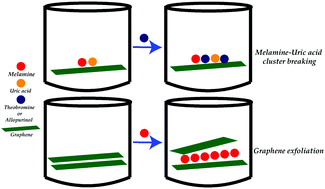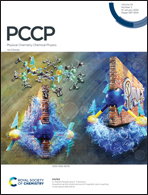Appraising the potency of small molecule inhibitors and their graphene surface-mediated organizational attributes on uric acid–melamine clusters†
Abstract
Uric acid (UA) and melamine (MM) crystallization in humans is associated with adverse medical conditions, including the germination of kidney stones, because of their low solubility. The growth of kidney stones, usually formed on renal papillary facades, is accomplished on the matrix-coated surface by the aggregation of preformed crystals or secondary crystal nucleation. Therefore, the effects of inhibitors such as theobromine (TB) and allopurinol (AP) on MM–UA aggregation are investigated by employing classical molecular dynamics simulations on a graphene surface. This impersonates the exact essence of the precipitation of kidney stones. The interaction between MM–UA is very intense and, thus, large clusters are formed on the surface. The presence of TB and AP will, however, substantially inhibit their aggregation. TB and AP significantly impede UA aggregation in particular. Therefore, lower order UA clusters are formed. These smaller UA clusters then pull a lower number of MM towards themselves, resulting in a smaller order UA–MM cluster. MM and UA aggregation on a 2D graphene surface is found to be spontaneous. There is no difference in these molecules' adsorption with a change in the force field parameters (i.e., GAFF and OPLS-AA) for graphene. Moreover, the greater the surface area of graphene, the more molecules are absorbed. The solute–surface van der Waals interaction energy plays a driving force in the adsorption of solute molecules on the surface. In addition, interactions like hydrogen bonding and π-stacking over the graphene surface involve binding all like molecules. These aggregated solute molecules strongly attract more like molecules until all solute molecules are adsorbed on the graphene surface, as estimated by enhanced sampling. The molecular origin of graphene exfoliation by MM is also described here. The present work helps to design novel kidney stone inhibitors.



 Please wait while we load your content...
Please wait while we load your content...